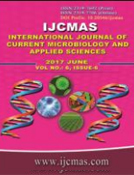


 National Academy of Agricultural Sciences (NAAS)
National Academy of Agricultural Sciences (NAAS)

|
PRINT ISSN : 2319-7692
Online ISSN : 2319-7706 Issues : 12 per year Publisher : Excellent Publishers Email : editorijcmas@gmail.com / submit@ijcmas.com Editor-in-chief: Dr.M.Prakash Index Copernicus ICV 2018: 95.39 NAAS RATING 2020: 5.38 |
Major threat to highly productive cotton belt of North India is Cotton Leaf Curl Disease exclusively transmitted by whitefly (Bemisia tabaci). The present investigation was carried out at Research farm of department of Agricultural Meteorology, CCS HAU, Hisar Haryana, to evaluate progression of CLCuD and whitefly (Bemisia tabaci) in relation to weather parameters. Three Bt -cotton hybrids were sown at three different dates. Per cent CLCuD incidence increases continuously from appearance to picking. Early sowing found to be more appropriate to minimize CLCuD infestation having less per cent disease incidence and whitefly population as compared to late sown crop. Correlation analysis reveals that per cent CLCuD incidence and whitefly population shows a significant negative correlation with temperature maximum and minimum while positively correlated with relative humidity morning and evening. Sunshine hours are significant positively correlated with both per cent CLCuD incidence and whitefly population. Whitefly population decreases with increased rainfall and negatively correlated with rainfall. Maximum variability (54.4%) in per cent CLCuD incidence appears due to temperature minimum.
 |
 |
 |
 |
 |